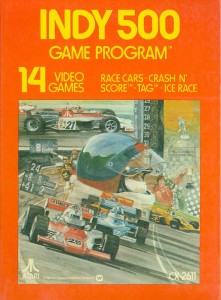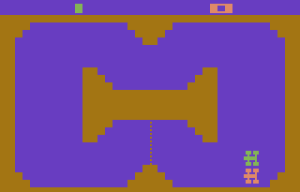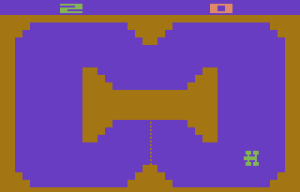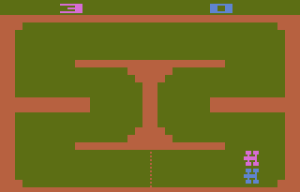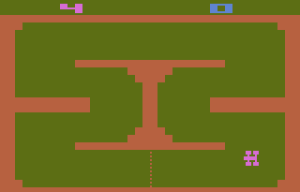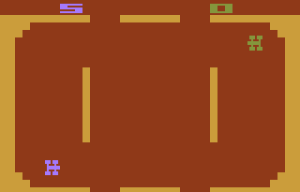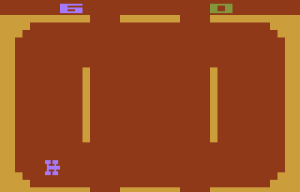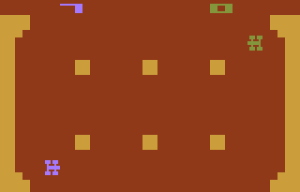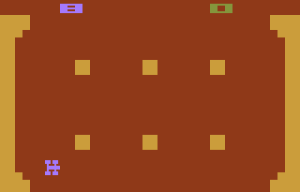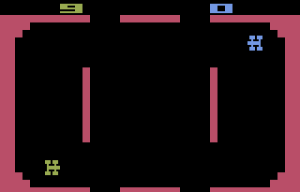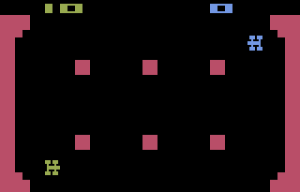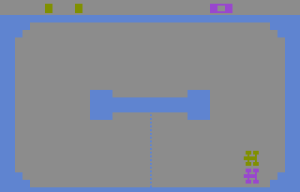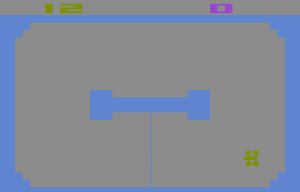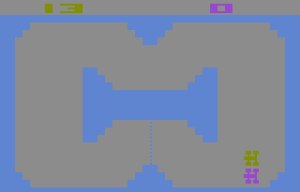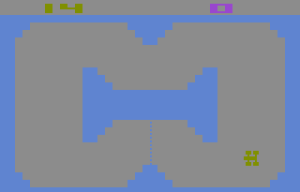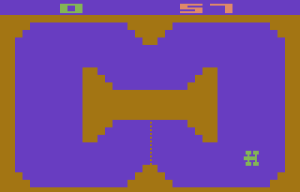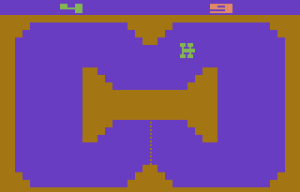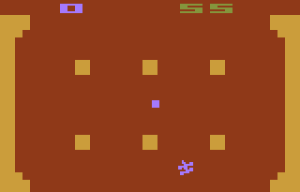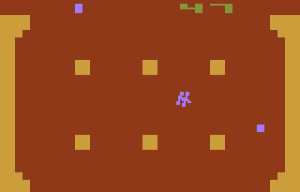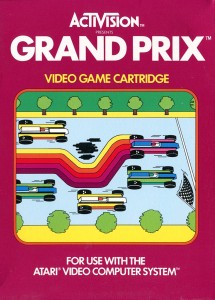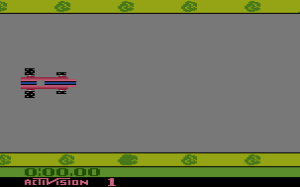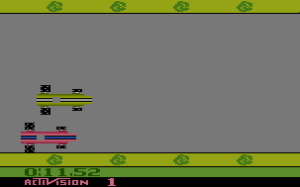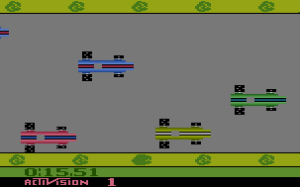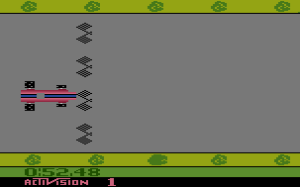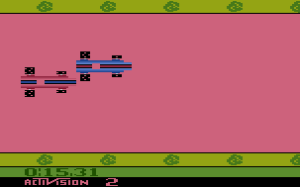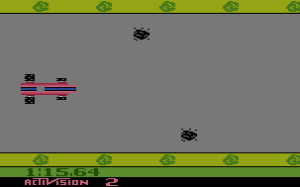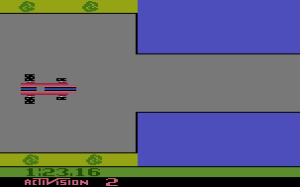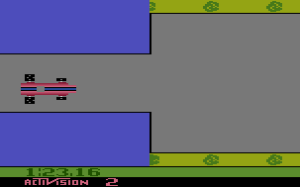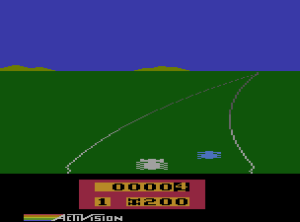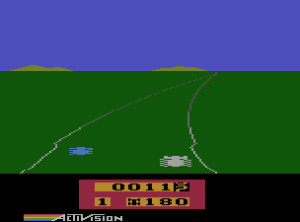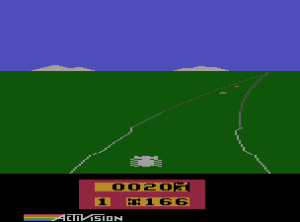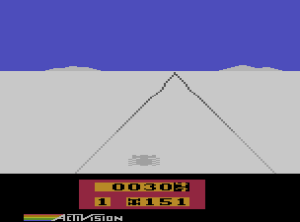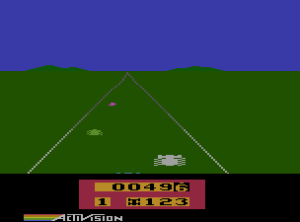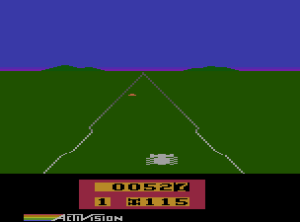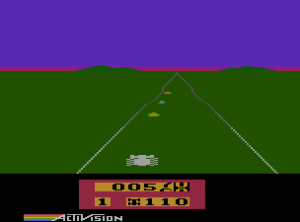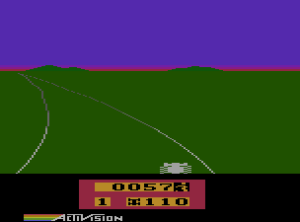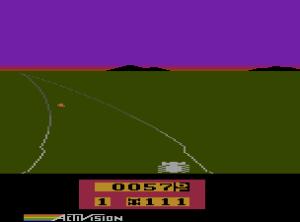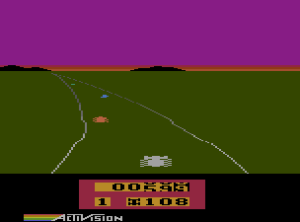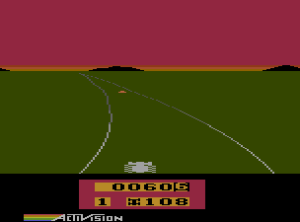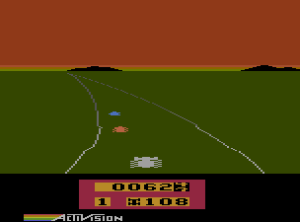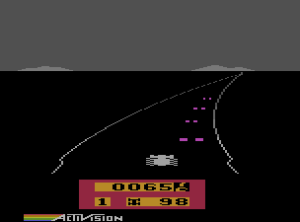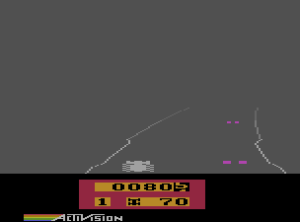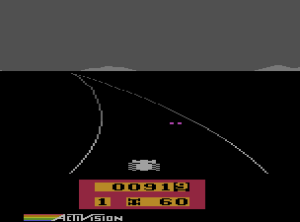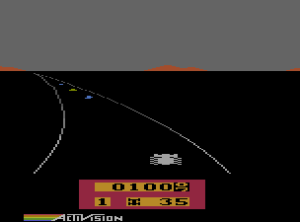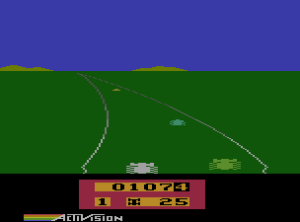Many game collectors and classic gaming enthusiasts start with the Atari. And for the most part, this is where home console gaming really began. But this system has some truly terrible games. Thankfully for us, it also has some extremely fun games that were programmed by early masters of the art.
Indy 500 (1977)
This game was a launch title for the Atari VCS, as it was known before later getting the name “Atari 2600”. You may not expect much out of it, but it’s actually quite good. I wouldn’t say that it’s “14 video games” like it says on the box though. There are just different race tracks, different modes of play, and single or two player variants of these. The console had some switches on it, and you could use the “select” switch to choose from the 14 variants:
This is the first available track, two player mode. As you can see, it is a top-down view. The brown obstacles aren’t walls, because you can drive the blocky cars through them, but doing so will slow you down a whole lot.
This is single player mode. The object here is to race against the clock and get in as many laps as you can in one minute.
second track, two player
single player
This track features the appearance of a target that appears in random locations. The object of the game here is to hit that target with your car to score a point. After the target is hit, another one will appear in a random location, and so on. The player with the highest score wins.
In the single player variant, you must score as many points as you can in a minute.
same game with a different track
single player
This is tag. One car starts out flickering, and that car is “it”. The other car must avoid being tagged, and when that car is tagged, that car becomes “it”. Points are awarded for avoiding being tagged.
same game, different track
This is the standard race we started off with, but it’s a race on ice. The driving physics have been changed so that when you turn or brake, your car slides all over the place.
single player ice race
different track
single player
So now you can see some action of the first race in single player mode. You’ll note that the minute counter has started ticking down, and I have 57 seconds left to make as many laps as I can.
I’ve only made four laps. This is a terrible score! With only nine seconds left, I may not be able to make it.
Above, you can see single player mode of the target race. Here’s my blocky car going for the target.
And now you can see I’ve turned around and I’m going for the next one to appear.
I usually don’t like top-down racing games. This is how racing and driving games started out due to hardware limitations, and there’s a reason why game developers have all but abandoned the top-down view. But I had fun playing Indy 500, and I was surprised to see all the different styles of play they crammed into the tiny cartridge. It’s even more remarkable to think that this came out in 1977.
This game was originally released with its own controller, the “driving controller”. It was similar to a paddle controller in most ways, only it didn’t have set start and end points and contained slightly different circuitry. If you want to check out this game on a real Atari 2600, you will need to get a driving controller as well. Thankfully, the wonderful z26 emulator handles joystick input in lieu of this controller just fine, so I was able to play this game without any problems. I highly recommend a download, and I highly recommend this game, especially if you have a friend you can play this with. As much fun as the single player games can be, they’re nothing like the enjoyment that can be had racing against an actual person.
Grand Prix (1982)
If anyone could make a great Atari 2600 game, it was Activision. They were the first third-party game developer, and they famously split from Atari when (as still Atari employees) they wanted to have more pay and recognition for what they did. Atari’s (presumably glue-sniffing) CEO balked and told them that anyone could make video games. Seeing as how you needed to program Atari 2600 games in fucking assembly and know what makes a fun game and know what looks appealing on the screen, I would say this assessment is dead wrong.
Activision discovered programming tricks that made the Atari do things that no one knew it could do, and it was thanks to them in no small part that the console had as long a lifespan as it did. One of these graphical tricks was multicoloured sprites. They’re not easy to do at all on the 2600. But have a look at your racing car in this game:
More than one colour for sure. And check out the detail on the tires. This is the kind of thing you just don’t see in the average Atari 2600 game. For this console, this officially counts as visually stunning. The hardware could actually handle an impressive 128 colours, while most other consoles and computers at the time could only handle a palette of 16. In the right hands, Atari 2600 games could turn out to look and play pretty damn good.
I think “Grand Prix” is the last of the side-scrolling racing games I’m reviewing. The pace can get pretty fast, and the object is to make it to the finish line. Of course, you must try to beat your previous time.
There are plenty of other cars in the race, and you must swerve around them and avoid hitting them. Doing so will slow you down and add valuable seconds to your time. Moving the joystick left will apply the brakes.
Ah, the finish line. There are four different tracks, and in the game manual they are named after real grand prix race courses. They are all perfectly straight though.
Above you can see what happens when you crash into another car. You see flashes of red, and you get to hear that Atari sound chip work its magic. I’m not impressed with Atari sound, and I’ve ranted about it before, so I won’t elaborate.
You must also watch out for oil slicks on the road. They won’t slow you down, but they will make you swerve randomly.
Tracks 2, 3 and 4 have sections of water that must be crossed on bridges. It breaks up the monotony of the regular street scene somewhat.
Overall, “Grand Prix” can be a fun game to pull out every now and then. The race does get very fast, and it is very challenging to play with the aim of not hitting cars. Despite the poor sound quality of the console, the sounds of the game are not bad. It’s a very quick game to play through though, and it’s single player only. I can recommend picking it up only if you’re a fan of the original Atari home console.
Enduro (1983)
Now this is a great game! And it’s no surprise at all to see the Activision logo again. I had never actually heard of Enduro before I started looking for driving games to review, and I’m so glad I found it because I instantly fell in love with this one. So forgive me if I’m gushing, but damn it, you need to play this game.
As you can see, it’s a racer with a third-person view. This is my favourite kind of racing game to play, followed closely by first-person. Enduro came out in 1983, and it’s by no means the first game to utilize this view, but it sure excels at it.
The object of the game here isn’t really to get to the finish line first. You do have to beat the clock, but here’s the idea behind the game. You are in an endurance race with hundreds of other cars, and you must pass a certain amount of them in a 24 hour period in order to be allowed to race the next day. Don’t worry, the in-game time doesn’t take a whole day to pass.
So you can see your odometer counting out the number of miles you’ve traveled. Below that on the right is a display showing the number of cars you have left to pass for that day. The digit next to that is the day that you are racing. You must pass 200 cars the first day, and 300 each day after. This isn’t as easy as you would think. Your car is a race car – of course – but you should not travel full speed all the time, for if you hit another car, you will immediately be slowed down and passed by many other cars. Then you will have to work to pass all those cars all over again. The more cars you hit, the more cars will pass you and the less your chance of racing the next day.
When I started playing Enduro, I noticed that the scenery started changing colour. I didn’t think much of it at first, because things changing colour on the Atari 2600 was kind of a gimmick to make things more interesting and to compensate for the lack of real graphics power. But the colour changes here depict the change from day to night and back again.
They also show you driving through a road covered in snow and ice. It’s easy to slide around on this road and even the sound of your engine and the cars passing you is different in this stage. I must admit, this is one of the best sounding Atari games I’ve ever played.
Now that the ice and snow is passed, you can see that the light is fading from the sky.
And the sun is setting…
Gosh it sure is purty…
Now that the sun has set, you are driving at night. All you can see of the other cars on the road are their tail lights.
After driving through most of the night, you get some fog. This stage is the hardest to get through because your visibility is so limited.
The fog lifts eventually…
…just before the dawn. If you haven’t passed enough cars by now, and still have dozens to go like me in the screenshot above, you’re in trouble.
The morning has come, and I only passed 175 out of the required 200 cars. This was only level one – the easy level. My excuse is that I was busy taking screenshots. I can usually finish this level, but I have yet to pass 300 cars for level two.
But this is the kind of game that makes you want to come back to it. The controls are great. Some racing games make me feel frustrated because I can’t get the vehicle under control when I need to. This is one of those games that makes me feel like I’m fully in control of what the car on screen is doing. The graphics are great for the system too. The screenshots don’t convey how smooth the motion is, and how good the scaling effects look on the other cars. Even the sound is great for an Atari 2600 game, which is a rarity.
I can’t recommend this game enough. Download the z26 emulator and give “Enduro” a try. Or dust off your old Atari and plug in that cartridge. This is a classic.
